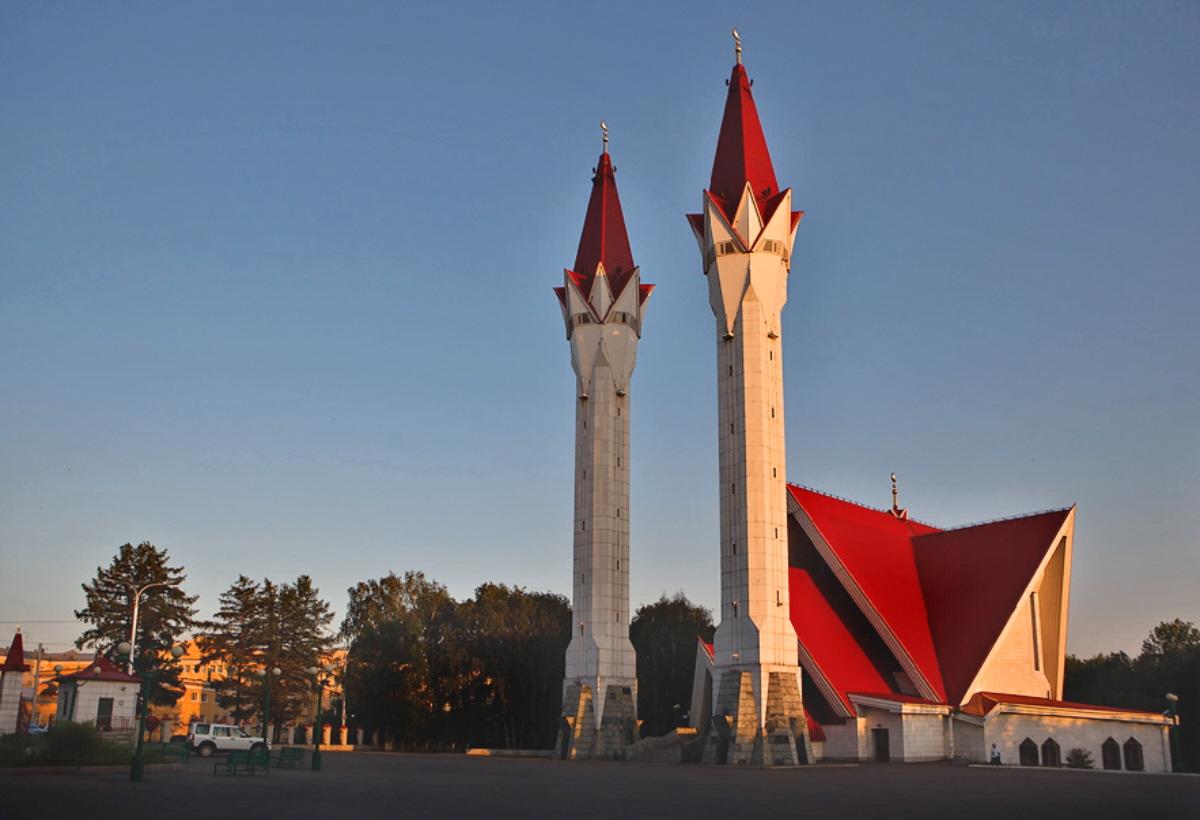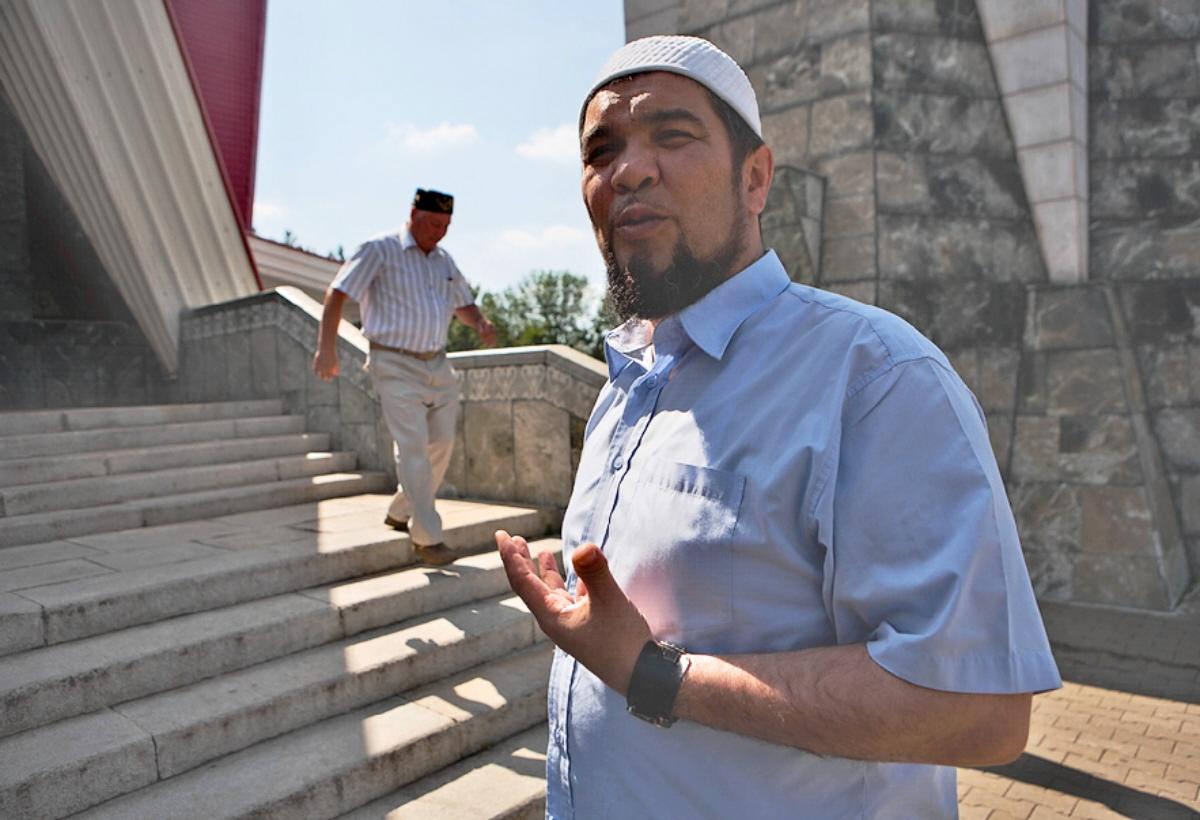
At the end of the 18th century, Tsaritsa Yekaterina Velikaya issued a decree forming the Muslim Spiritual and Legal Administration in Ufa under the leadership of a Muftiate. Since then, Ufa has been the centre of Russian Islam. In 1998, one of the most unusual and beautiful mosques, the Lala-Tulip Mosque, was built in Ufa. Granted, the appearance of the mosque is rather unusual. It’s modern, yet, at the same time, it’s still clearly understood as to its purpose. Don’t be mistaken… this is a mosque.
******

Ali was our guide through the mosque-madrasah; he had an upbeat attitude and his commentary on the place was knowledgeable, that’s not to mention his infectious cheerfulness. This mosque isn’t just a place of prayer; it’s really a spiritual centre. It has an attached educational institution and dormitory with its own Muslim prayer-hall, an assembly chamber for the meetings of Muslim religious leaders, a library, and a conference area. In total, the nave of the mosque can accommodate about a thousand worshippers.
******

Moreover, everyone’s welcome here, not just Muslims. All that they ask is that you respect their traditions and take off your shoes before entering the building; then, anyone can walk inside.
******

The interior is more traditional than the exterior is… its decoration is clearly minimalist. Muslims believe that we shouldn’t be distracted whilst we’re at prayer, that’s why men and women pray in separate areas {that’s why Orthodox Russians, traditionally, stood in gender-segregated groups in the church during services: editor}. People take off their shoes before entering the mosque for the sake of cleanliness. The faithful kneel on the floor, and they prostrate themselves on the carpet as they pray {Orthodox Christians also use this posture of prayer: editor}.
******

In 1773, Tsaritsa Yekaterina Velikaya enacted a decree establishing tolerance of religion…. “As the Almighty tolerates all faiths, languages, and confessions, therefore, Her Majesty deigns that love and harmony should exist amongst all those who accept her sovereignty”. She issued this decree at a time when her realm was in turmoil. Pugachyov’s rebellion engulfed the regions of Tatarstan, Bashkortostan, Udmurtia, Saratov, Chelyabinsk, and Orenburg. To help put down the revolt, the Tsaritsa issued decrees ordering local authorities to reinforce the state’s authority by exercising religious tolerance.
******

All mosques received legal rights; they could enclose their perimeters within fences, they could erect caravanserais, and they could organise schools. In 1788, an imperial decree established the Muslim Spiritual and Legal Administration in Ufa, under the control of a Muftiate.
******

Therefore, Ufa became the centre of Russian Muslim life. Today, Ufa is the seat of the Muslim spiritual leadership for Russia and the European CIS countries. This Muslim Spiritual Administration was unique. In the normal course of events, Muslims didn’t need a centralised organisation to pray to Allah; if they didn’t understand something, they asked for a judgement from a Mullah. However, from the state’s point of view, it was a sound move, for it allowed the Spiritual Administration to order the social life of the Russian Muslims under the aegis of Russian legislation.
******

People often ask, “Why is Ufa the centre of Russian Islam, why not Kazan?” The answer’s obvious… Russia conquered Kazan… Bashkortostan voluntarily joined the Russian Empire. In the eyes of the state authorities, Ufa was a more logical choice for the location of the muftiate rather than Kazan. Echoes of Ivan Grozny’s conquest of Kazan are still visible, such as the Kul Sharif Mosque in the Kazan Kremlin {Ivan Grozny’s men destroyed the original mosque during the taking of the city, the present mosque is a late 20th century replacement: editor}.
******

Let’s return to our time. Today, any Muslim can come to the Lala-Tulip Mosque to ask for guidance or for an explanation of any spiritual question. At the mosque, there are special courses open to anyone where you can get an introduction to the Koran and the fundamentals of Islam. It’s also the venue for many meetings, conferences, and congresses. Each year, about a hundred people graduate from the Islamic Institute attached to the mosque. Most of its students take external correspondence courses, but there’s room for 60 students in the dormitories attached to the Institute.
******

Our guide, Ali, graduated from the Institute; now, he helps out there as a form of gratitude {шакирдам is a transliteration of the Arabic shakir (“gratitude”), therefore, it seems that his gratitude has a religious element to it… it appears that he seems to view it as an obligation: editor}. His most cherished dream is to perform the Hajj to Mecca. By the way, today, most people no longer go overland to Arabia, most fly there. Despite the common perception that Islam’s rigorous, that isn’t so. For example, Muslims can divorce under their religious law, and both men and women may initiate such a move. In conclusion, as I said earlier, the architecture of the mosque is most unusual and beautiful.
17 August 2011
Тадахии зизись (Tadakhii zizis)
http://zizis.livejournal.com/179120.html













You must be logged in to post a comment.